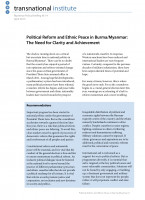Military Confrontation or Political Dialogue Consequences of the Kokang Crisis for Peace and Democracy in Myanmar
Topics
Regions
At a time of critical political transition in Myanmar, failure to address the root causes of armed conflict and to create an inclusive political process to solve nationality grievances is only likely to have a very detrimental impact on the prospects for peace, democracy and development

Downloads
-
Military Confrontation or Political Dialogue - Consequences of the Kokang Crisis (PDF, 755.82 KB)Average time to read: 60 minutes minutes
Introduction
The renewed violence in the Kokang region of the northern Shan state in February 2015 has had serious repercussions for efforts to solve ethnic conflict in Burma/Myanmar and end the decades-old civil war. The fighting started when troops led by the veteran Kokang leader Pheung Kya-shin (Peng Jiasheng) resurfaced in the Kokang region and attacked government and army positions after an interval of nearly six years. Pheung Kya-shin’s Myanmar National Democratic Alliance Army (MNDAA), a former ceasefire group and government ally, was ousted from the Kokang region in 2009 by a rival Kokang leader with the help of the Tatmadaw (national armed forces). This coup happened after Pheung’s MNDAA had refused to accept the demand of the previous military government to transform into a Border Guard Force (BGF).
The outbreak of renewed conflict in the Kokang region has, in turn, clouded the prospects of achieving a nationwide ceasefire agreement (NCA) in Myanmar. Battles broke out while negotiations were ongoing in Yangon. For while other ethnic armed organisations have called for peace talks and a halt to the renewed fighting, the quasi-civilian government under President Thein Sein has so far refused to address the Kokang crisis by political means. The Tatmadaw has responded with a large military offensive, supported by air strikes, in an all-out effort to drive out the MNDAA from the Kokang region. Although the MNDAA declared a unilateral ceasefire in June, the conflict continues and the MNDAA is still holding ground, with the Tatmadaw making rare public admissions of taking casualties.
Recommendations
- The renewed violence in the Kokang region has serious repercussions for efforts to solve ethnic conflict in Myanmar and clouded the prospects for achieving a nationwide ceasefire agreement. Fighting has spilled across the Yunnan province border and strained relations with China, Myanmar’s largest foreign investor.
- The return of conflict to the Kokang region follows an unaddressed pattern of increased military operations and instability in the Kachin and northern Shan states since President Thein Sein assumed office in 2011. It is vital that peace is achieved and all nationality peoples, including the Kachin, Kokang, Shan and Ta-ang, are included in nationwide ceasefire talks and political dialogue. Conflict in any part of the country can quickly lead to national instability.
- The humanitarian consequences of the renewed fighting in northeast Myanmar are profound. Since 2011, around 200,000 civilians have been displaced in the Kachin and northern Shan states, many of whom have fled towards the China border. Amidst rising Buddhist nationalism in Myanmar, the Kokang conflict also raises the risk of anti-Chinese sentiment in the country.
- Failure to address the root causes of armed conflict and to create an inclusive political process will have a detrimental impact on the prospects for peace, democracy and development. Military solutions to ethnic conflict must no longer be pursued, and an inclusive political dialogue should start as soon as possible. Peace in Myanmar needs to move from arguments about process to agreements about delivery. It is time to end military confrontation and to start political dialogue.

